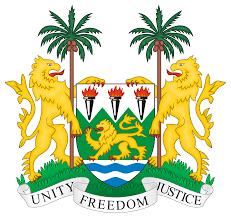Sierra Leone
Sierra Leone Home

A virtual guide to Sierra Leone, a tropical country on the coast of West Africa, bordered by the Atlantic Ocean in the south-west, by Liberia in the south-east and it is half surrounded by Guinea in north and northeast.
In the late 18th and early 19th centuries, the region around Freetown was used by the British to 'resettle' freed slaves, London's "Black Poor", and many African American refugees from the American Revolution. Sierra Leone was since 1808 a British Crown Colony, the country gained independence in 1961. Today it is the poorest nation in the Commonwealth.
With an area of 71,740 km², the country is just slightly larger than Ireland or slightly smaller than the U.S. state of South Carolina. The country's landscape offers a flat coastal belt, the eastern half of the nation is covered by hills and high mountains, part of the Guinea highlands, Mount Bintumani (1,948 m (6,391 ft)) within the Loma mountains in Koinadugu (Northern Province) is the highest peak in the country. The main rivers are the Tai river, the Sewa (Sew), and the Moa River.
Sierra Leone has a population of 7 million people (census 2015), its largest city, chief port and capital are Freetown, the city is situated in north-west of the country at the coast of the North Atlantic Ocean.
Spoken languages are English (official), English Creole, Temne, Mende and other West African languages. Islam (78%) and Christianity (21%) are the two main religions in the country.
Sierra Leone lies within Africa's tropical zone, with a climate that offers two seasons, the rainy season from May to December, and a dry season from December to May.
Background:
1991 to 2002 civil war between the government and the Revolutionary United Front (RUF) resulted in tens of thousands of deaths and the displacement of more than 2 million people (about one-third of the population), many of whom are now refugees in neighbouring countries.
National elections were held in May 2002 and the government continues to slowly re-establish its authority. However, the gradual withdrawal of most UN Mission in Sierra Leone (UNAMSIL) peacekeepers in 2004 and early 2005, deteriorating political and economic conditions in Guinea, and the tenuous security situation in neighbouring Liberia challenged the continuation of Sierra Leone's stability.
In March 2014, the closure of the UN Integrated Peacebuilding Office in Sierra Leone marked the end of more than 15 years of peacekeeping in the country.
Sign in to add your comment.
Suggested Pages
Official Name:
Republic of Sierra Leone
Short form: Sierra Leone
ISO Country Code: sl, SLE
Time:
Local Time = UTC
Country Calling Code: +232
Capital City: Freetown (1 million)
Other Cities: Bo, Kenema, Lungi, Makeni, Yengema
Government:
Type: Republic with a democratically elected President and Parliament.
Independence: 27 April 1961 (from Britain).
Constitution: 1 October 1991.
Geography:
Location: Western Africa, bordering the North Atlantic Ocean, between Guinea and Liberia.
Area: 71,740 km² (27,698 sq. mi.)
Terrain: Three areas are a coastal belt of mangrove swamps, wooded hills along with the immediate interior, and a mountainous plateau in the interior.
Highest point: Loma Mansa (Bintimani) 1 948 m
Climate: tropical; hot, humid; summer rainy season (May to December)